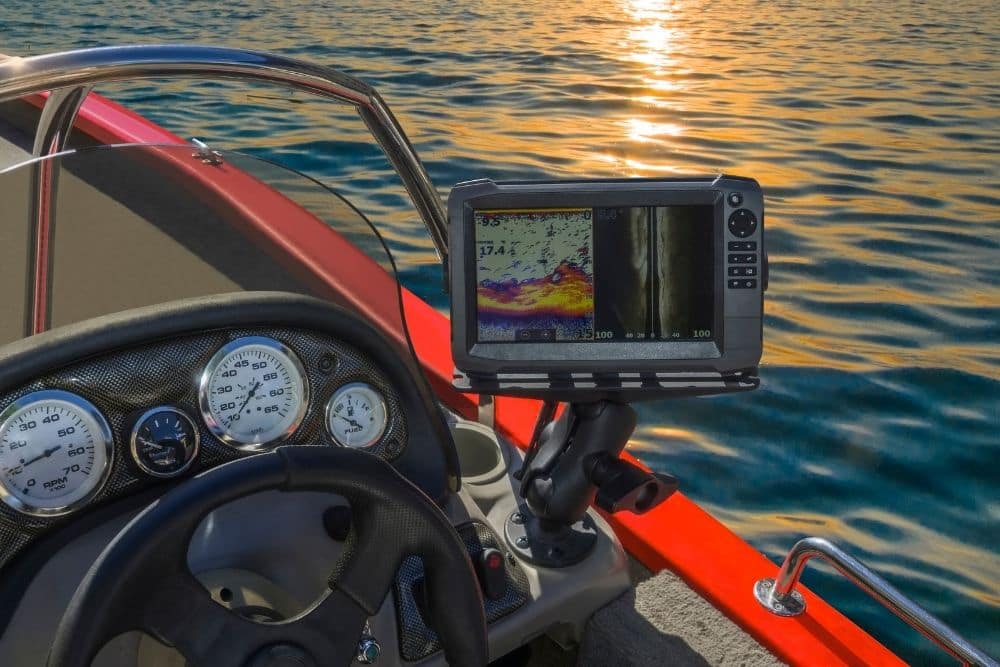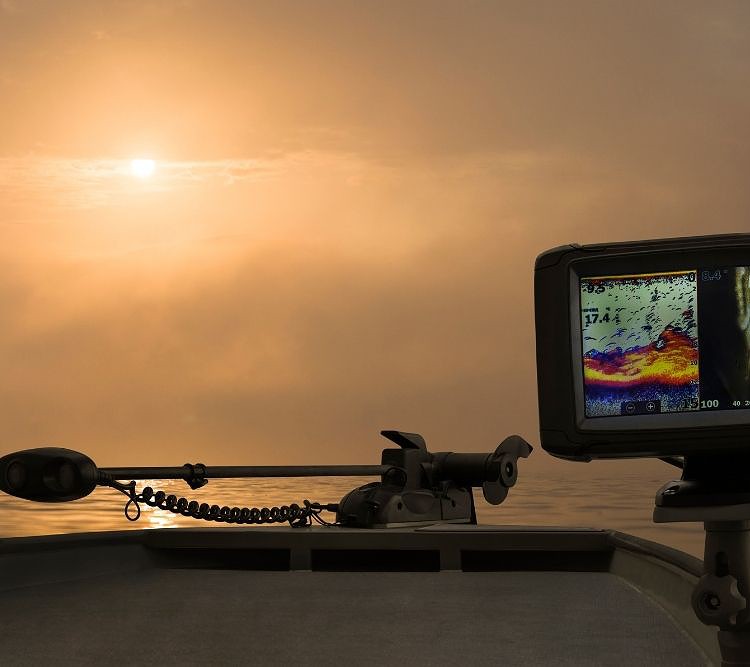Can’t’ seem to decide between down imaging or side imaging sonar devices?
Well, you’ve found yourself in the middle of an age-old debate; one that very few people have sufficient knowledge to answer.
You see, you’re considering owning a sonar fish finder with down imaging or side imaging, but what you need to understand is that either of the two can be used at any given point in time.
Both of these devices can grant the user the ability to detect fish underwater, but both devices do so in their own unique way.
If you keep scrolling through, you will gain a better understanding of which of the two is a better option for you. However, before we do a deep dive into the advantages and disadvantages of down imaging and side imaging, let’s quickly review how either device works.
Table of Contents
What is Side Imaging?

A side imaging sonar fish finder scans horizontally underwater on either side of the boat. The main advantage here is that it grants you the ability to quickly scan two places simultaneously.
With that said, side imaging devices aren’t necessarily the best choice for people who are trying to search for smaller fish. This is because most people using them with trolling motors will simply cruise by without ever noticing them.
Side imaging fish finders are typically used in shallow waters since they produce the best results on both sides of the boat in these parts of water. For instance, if you’re cruising through a creek or river, these devices will be a great choice.
What is Down Imaging?

Down imaging sonar fish finders can show you everything that may be happening right underneath your boat. These transducer devices work by emitting sonar waves right under your boat and then displaying where solid structures or fish are located right beneath, partially behind or partially in front of the boat.
Most fish finders in the industry tend to use down imaging, but this is usually the case because these devices are cheaper and much easier to use as compared to side imaging devices. Also, down imaging devices are most commonly used to locate smaller fish, which include panfish and bass.
In addition, whenever you look up down imaging sonar devices on the internet, you will come across words such as ‘DI’, ‘DownScan’, or ‘DownVu’. All of these terms are one and the same and are used interchangeably to describe a fish finder device as a down imaging device.
If you see any of these terms on a device, you should automatically know that it is meant to show you whatever is underneath your boat.
Which Works Best With a Trolling Motor?

We’ve received plenty of queries from fellow anglers regarding the effectiveness of mounting their Humminbird Side Imaging and Down Imaging transducer onto their trolling motor.
While either device can certainly be mounted there, it is not something we would advise. This is especially true with your down imaging device as you will only see a distorted 2D image with a blurred effect.
This certainly does not mean that the down imaging device wouldn’t read, but the problem is that its reading wouldn’t be as accurate as you would like it to be.
On the other hand, a side imaging transducer will be able to take images of both the perpendicular sides of your boat. Also, when you turn your boat with a trolling motor, the SI device will produce readings at an angle on and off the boat.
If you don’t prefer to work with the 360-degree angles provided by side imaging devices, you might be able to do a lot better with the traditional Humminbird WiDi. Still, reading a side imaging device while it is mounted on a trolling motor isn’t really that difficult and is much like piecing together pieces of a puzzle.
While all of the above is much easier to understand in practice, let’s try and break it down for you with a good ol’ list of pros and cons
Down Imaging
Pros
- Down imaging works best when you’re cruising in deep waters. If your approach to fishing is more vertical than horizontal, then down-imaging sonar fish finders are better suited for your purpose.
- These devices can produce somewhat reasonable results while you’re cruising at high speeds. In contrast, side imaging devices work better while cruising at slow speeds.
Cons
- Most down-imaging sonar systems tend to only rely on just one transducer. This often results in lesser information for the device to work with and, therefore, produces lower-resolution results.
- These devices also fail to provide users with as effective horizontal data as compared to side-imagine devices. For instance, you will have the ability to determine whether a larger fish is about 15 feet underneath your boat, but you will have no clue as to which side of the boat it is on (it could either be 50-yards to the right or the left or even anywhere in between).
Side Imaging
Pros
- Side imaging devices allow the user to scan the water more quickly since they scan in both directions simultaneously. Naturally, this covers 2x more water as compared to down imaging devices.
- These devices provide a clearer image of the marine environment since they have a more efficient point-of-view as compared to their alternative.
For instance, if you are using a down-imaging device, various piles of rock on the left and right of the boat will be shown as a single structure of rock. In contrast, side imaging devices display these rocks as distinct structures on either side of the boat. - These devices are effective in locating shoals of fish that may be behind shallow bays or creeks as their orientation will provide a better image. It is a common practice for anglers with both devices to switch to side imaging systems when they enter shallow waters.
Cons
- Side imaging devices are commonly more expensive as compared to down-imaging devices. Even though these devices are every bit worth the additional cost, most anglers on a budget tend to prefer the cheaper option.
- These devices cannot produce defined images of underwater substances under the boat. If you’re anything like us, these devices will only build more curiosity as to what specific cover is underneath your boat.
- Side imaging devices can only be operated while your boat is cruising at a low speed. This can make it challenging for anglers to try and race across a body of water to another potential fishing spot. (However, this particular disadvantage is offset by the device’s ability to scan more water at a time.)
Can One Device Replace the Other?
Both of these sonar devices have their specific set of advantages and disadvantages. Each device operates uniquely, and we’ve found that the best results can be achieved if you put them together.
We recommend you combine the pros and cons of both down imaging and side imaging devices by buying combo products.
If you can afford these, you’re bound to come across some great options on Amazon. They’ll be labelled ‘dual scan’ or ‘triple threat’ by brands like Lowrance HDS, Humminbird and Garmin.
Alternatively, try looking for the word ‘Chirp’ as it refers to both kinds of scanning devices. Chirp signifies a kind of 2D sonar fishing technology. It can be described as a continuous sonar blast that is sent underwater from the sonar unit.

|
Down Imaging |
Side Imaging |
|
Budget option |
Expensive |
|
Only captures what is below the boat |
Can’t capture what is below the boat |
|
Can be effective at high speeds |
Can only be operated at slow speeds |
| Most effective in deep waters |
Most effective in shallow waters |
|
Produces low-resolution images |
Provides a more detailed point of view |
|
They can’t provide as much horizontal data as their alternative |
Can scan larger areas of water more quickly |
Our Verdict
To decide which of the two is perfect for your needs, you need to consider where you plan on fishing and how you will fish when you get there.
If you are the kind of angler who spends most of their time in shallow water, down imaging isn’t going to be of any use to you. With a down imaging device, you’ll be more concerned about what’s going in areas of the water you access with a boat.
However, if you plan on spending more time in deeper water to wait for the fish to come towards your boat, you shouldn’t worry about side imaging. A downscan should provide you with the best results and all you will have to do is stay right where you are and let the device do its trick.
Similarly, if you’re into ice fishing, you are going to want to buy a down imaging device since it can determine exactly where you should drill a hole. Side imaging wouldn’t do you any favors here and most devices wouldn’t even be able to produce readable results while you’re over ice.
Lastly, if you plan on spending most of your days with a trolling motor, a side imaging device will be the way to go since you will be moving at a slow and steady pace. The added benefit here would be that you can capture great results on both sides of your boat.

I created this site to help people – to help you – with your boat problems. Instead of helping one person at a time, I want this website to be the “one-stop-shop” for everyone’s boating concerns. Read more.




